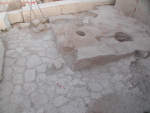1. OVERVIEW
| Roster | Date | Author | Record |
|---|---|---|---|
| Category | !! | !! | other features |
| Best definition | 2002-09-11 | !! | rodent hole [Input: -MX12-99.j] |
| Best image | 2011-12-12 | lC |  v114d [Input: VZ12LC.j] |
2. IDENTIFICATION
Designation
| Roster | Date | Author | Record |
|---|---|---|---|
| Definition | 2002-09-11 | fAB | rodent hole [Input: -MX12-99.j] |
| Description (summary) | 2002-09-11 | lR | Small round hole located 130cm from the top of pit f216 in the lowest level. The hole begins on the northeast side and runs along the same angle then turns. A meter tape was inserted and measured 70cm deep and appears to continue. This hole may be a rodent hole with other possibilities including a piece of wood or an outlet for the collection drain of the stone pavement a12. [Input: N304LR2.j] |
3. STRATIGRAPHY
Recovery/Assignment
| Roster | Date | Author | Record |
|---|---|---|---|
| Daily notes about recovery of elements | 2002-09-17 | aP | Today during the excavation of pit f216 we found a small circular hole 43 cm below the baked bricks located on the eastern section. It was excavated and emptied with a spoon by Hamadi since the fill proved soft and excavating it with a spoon would preserve the original face of this hole without scraping off any original markings. [Input: -MX12-99.j] |
| Argument | 2002-09-17 | aP | There are two possible explanations: it could be connected with the drain, which seems to flow not far or it could be a rodent hole. It's difficult that it could be in relation with the drain because the duct goes down toward north/east and doesn't go up joining with the drain. A link with the drain is suggested by the presence of laminations close to the hole. It seems however strange that it's a rodent hole because the circumference is very clear. We took the relay and a sample to study the soil. [Input: M917AP.j] |
| 2002-09-17 | lR | This circular hole in the Northeast corner of f216 could be a number of things such as the remains of wood that had disintegrated over the years and left a circular hole in its place, a rodent hole, or an outlet/inlet of some sort associated with the baked bricks on top. The rodent hole appears cut into the reddish packing material f339 a very pure clay. It seems odd to have water associated with this hole unless it was plastered with bitumen, which does not seem to be the case. The reddish clay f339 when wet turns into a plastic clay, which one assumes if water was passing through the hole, would eventually collapse or dissolve away. Possibly a tubing material was set in place and was later removed by the people who cut pit f216. This hole is at the level of the cobbles f338 which can be associated with water. This hole may simply just be a hole created by a small animal in which some water funneled through smoothing out the circumference of the hole to appear man-made. The situation will be further investigated next season when we excavate the pit further. [Input: M917AP.j] | |
| Procedures | 2014-12-03 | cJC | Some types of contact reconstructed from text description [Input: YY06CJC.j] |
Volumetric Localization
| Roster | Date | Author | Record |
|---|---|---|---|
| Locus | 2002-09-11 | fAB | k207 [Input: -MX12-99.j] |
| Relays (applicable to elements) | 2002-09-10 | lF | r347 (41848 36942 - 8533) [Input: M911LR-R.j] |
| 2002-09-10 | lF | r348 (41274 37275 - 8505) [Input: M911LR-R.j] | |
| 2002-09-10 | lF | r349 (41754 37185 - 8532) [Input: M911LR-R.j] | |
| 2002-09-10 | lF | r350 (41667 37324 - 8531) [Input: M911LR-R.j] | |
| 2002-09-10 | lF | r351 (41095 36913 - 8553) [Input: M911LR-R.j] | |
| 2002-09-11 | lF | r352 (41467 37373 - 8419) [Input: M911LR-R.j] | |
| 2002-09-11 | lF | r353 (41193 36792 - 8529) [Input: M911LR-R.j] | |
| 2002-09-11 | lF | r354 (41668 37098 - 8520) [Input: M911LR-R.j] | |
| 2002-09-11 | lF | r355 (41381 37193 - 8553) [Input: M911LR-R.j] | |
| 2002-09-11 | lF | r356 (41152 37270 - 8558) [Input: M911LR-R.j] | |
| 2002-09-11 | lf | r352 (41467 37373 - 8419 / Relay location: @side) [Input: R7QFAB1R.j] |
Contact Association
| Roster | Date | Author | Record |
|---|---|---|---|
| Type of contact: latest events | 2014-12-03 | cJC | f216 (fill) cuts f290 (rodent hole) [Input: YY06CJC.j] |
| Type of contact: contemporary events/movable items | 2002-09-10 | !! | q755.5 (sample) sits in f290 (rodent hole) [Input: MX12LR.j] |
| 2002-09-10 | fAB | q755 sits in f290 (rodent hole) [Input: MX12LR.j] | |
| 2002-09-10 | !! | q755-p1 (i) sits in f290 (rodent hole) [Input: MX12LR.j] | |
| Type of contact: earliest events | 2014-12-03 | cJC | f290 (rodent hole) cuts f339 (layer) [Input: YY06CJC.j] |
| Ceramic typological distribution | !! | !! | frequencies of ceramic vessels and sherds included within feature |
Time Sequencing
| Roster | Date | Author | Record |
|---|---|---|---|
| Stratum (to which element belongs) | 2015-05-20 | cJC | s10AAH [Input: ZA520CJC.j] |
| Phase (to which element belongs) | 2015-05-20 | !! | h9sAAH [Input: ZA520CJC.j] |
| Notes on time sequencing | 2005-11-13 | mKB | only 1 type sherd, date UC [Input: P902MKB.j] |

